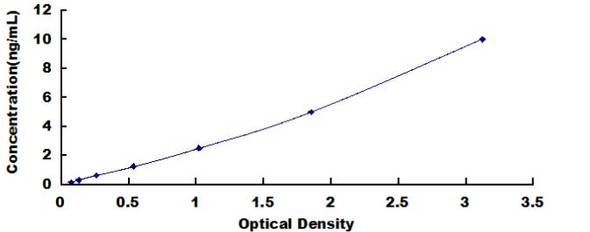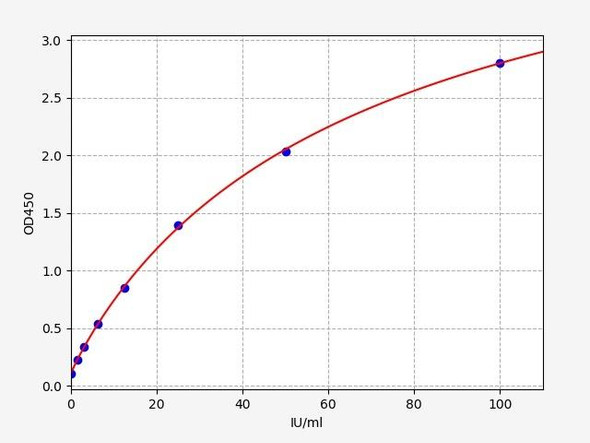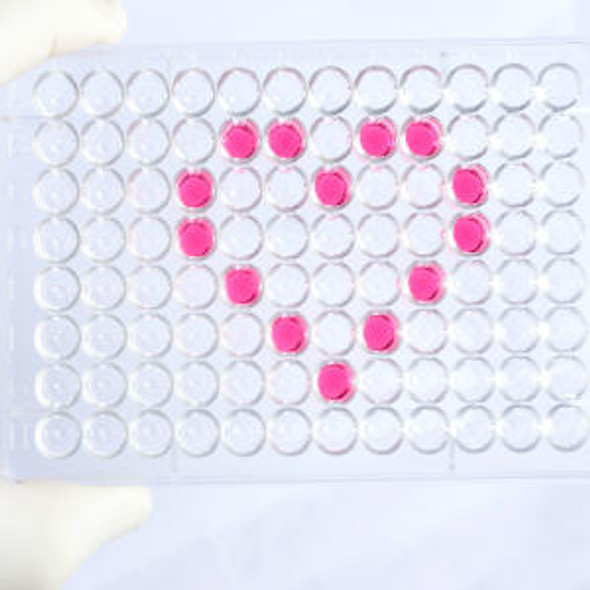Human Hexosaminidase B / HEXB ELISA Kit
- SKU:
- HUFI02055
- Product Type:
- ELISA Kit
- Size:
- 96 Assays
- Uniprot:
- P07686
- Sensitivity:
- 0.938IU/ml
- Range:
- 1.563-100IU/ml
- ELISA Type:
- Sandwich
- Synonyms:
- HEXB, ENC-1AS, N-acetyl-beta-glucosaminidase subunit beta, Beta-N-acetylhexosaminidase subunit beta, Hexosaminidase subunit B, Cervical cancer proto-oncogene 7 protein, HCC-7, ENC-1AS, HCC-7, HEL-248, beta-hexosaminidase subunit beta, Beta-N-acetylhe
- Reactivity:
- Human
- Research Area:
- Signal Transduction
Description
Human Hexosaminidase B / HEXB ELISA
Beta-hexosaminidase is composed of two subunits, alpha and beta, which are encoded by separate genes. The enzyme's alpha and beta subunit genes are the most frequently mutated genes. GM2 ganglioside accumulation in neurons and neurodegenerative diseases called the GM2 gangliosidoses is caused by mutations of the alpha or beta subunit genes. Diseases associated with HEXB include Tay-Sachs disease and Sandhoff disease . Pathways associated with HEXB include Metabolic pathways and GM2 gangliosidosis. Gene Ontology (GO) annotations related to HEXB include polysaccharide alpha-1,3-galactosidase activity
| Product Name: | Human Hexosaminidase B / HEXB ELISA Kit |
| Product Code: | HUFI02055 |
| Size: | 96 Assays |
| Alias: | HEXB, ENC-1AS, N-acetyl-beta-glucosaminidase subunit beta, Beta-N-acetylhexosaminidase subunit beta, Hexosaminidase subunit B, Cervical cancer proto-oncogene 7 protein, HCC-7, ENC-1AS, HCC-7, HEL-248, beta-hexosaminidase subunit beta, Beta-N-acetylhexosaminidase subunit beta, Cervical cancer proto-oncogene 7 protein, hexosaminidase B, beta polypeptide, Hexosaminidase subunit B, N-acetyl-beta-glucosaminidase subunit beta |
| Detection method: | Sandwich ELISA, Double Antibody |
| Application: | This immunoassay kit allows for the in vitro quantitative determination of Human HEXB concentrations in serum plasma and other biological fluids. |
| Sensitivity: | 0.938IU/ml |
| Range: | 1.56-100IU/ml |
| Storage: | 4°C for 6 months |
| Note: | For Research Use Only |
| Recovery: | Matrices listed below were spiked with certain level of Human HEXB and the recovery rates were calculated by comparing the measured value to the expected amount of Human HEXB in samples. | ||||||||||||||||
| |||||||||||||||||
| Linearity: | The linearity of the kit was assayed by testing samples spiked with appropriate concentration of Human HEXB and their serial dilutions. The results were demonstrated by the percentage of calculated concentration to the expected. | ||||||||||||||||
| |||||||||||||||||
| CV(%): | Intra-Assay: CV<8% Inter-Assay: CV<10% |
| Component | Quantity | Storage |
| ELISA Microplate (Dismountable) | 8×12 strips | 4°C for 6 months |
| Lyophilized Standard | 2 | 4°C/-20°C |
| Sample/Standard Dilution Buffer | 20ml | 4°C |
| Biotin-labeled Antibody(Concentrated) | 120ul | 4°C (Protect from light) |
| Antibody Dilution Buffer | 10ml | 4°C |
| HRP-Streptavidin Conjugate(SABC) | 120ul | 4°C (Protect from light) |
| SABC Dilution Buffer | 10ml | 4°C |
| TMB Substrate | 10ml | 4°C (Protect from light) |
| Stop Solution | 10ml | 4°C |
| Wash Buffer(25X) | 30ml | 4°C |
| Plate Sealer | 5 | - |
Other materials and equipment required:
- Microplate reader with 450 nm wavelength filter
- Multichannel Pipette, Pipette, microcentrifuge tubes and disposable pipette tips
- Incubator
- Deionized or distilled water
- Absorbent paper
- Buffer resevoir
| Uniprot | P07686 |
| UniProt Protein Function: | HEXB: Responsible for the degradation of GM2 gangliosides, and a variety of other molecules containing terminal N-acetyl hexosamines, in the brain and other tissues. Defects in HEXB are the cause of GM2-gangliosidosis type 2 (GM2G2); also known as Sandhoff disease. GM2- gangliosidosis is an autosomal recessive lysosomal storage disease marked by the accumulation of GM2 gangliosides in the neuronal cells. GM2G2 is clinically indistinguishable from GM2- gangliosidosis type 1, presenting startle reactions, early blindness, progressive motor and mental deterioration, macrocephaly and cherry-red spots on the macula. Belongs to the glycosyl hydrolase 20 family. |
| UniProt Protein Details: | Protein type:Carbohydrate Metabolism - amino sugar and nucleotide sugar; EC 3.2.1.52; Glycan Metabolism - glycosaminoglycan degradation; Glycan Metabolism - glycosphingolipid biosynthesis - ganglio series; Glycan Metabolism - glycosphingolipid biosynthesis - globo series; Glycan Metabolism - other glycan degradation; Hydrolase Chromosomal Location of Human Ortholog: 5q13.3 Cellular Component: acrosomal vesicle; azurophil granule; extracellular region; lysosomal lumen; membrane Molecular Function:acetylglucosaminyltransferase activity; beta-N-acetylhexosaminidase activity; protein heterodimerization activity; protein homodimerization activity Biological Process: astrocyte cell migration; cellular calcium ion homeostasis; cellular protein metabolic process; chondroitin sulfate catabolic process; ganglioside catabolic process; glycosphingolipid metabolic process; hyaluronan catabolic process; keratan sulfate catabolic process; lipid storage; locomotory behavior; lysosome organization and biogenesis; male courtship behavior; myelination; neuromuscular process controlling balance; neutrophil degranulation; oligosaccharide catabolic process; oogenesis; penetration of zona pellucida; phospholipid biosynthetic process; positive regulation of transcription from RNA polymerase II promoter; regulation of cell shape; sensory perception of sound; skeletal system development Disease: Sandhoff Disease |
| NCBI Summary: | Hexosaminidase B is the beta subunit of the lysosomal enzyme beta-hexosaminidase that, together with the cofactor GM2 activator protein, catalyzes the degradation of the ganglioside GM2, and other molecules containing terminal N-acetyl hexosamines. Beta-hexosaminidase is composed of two subunits, alpha and beta, which are encoded by separate genes. Both beta-hexosaminidase alpha and beta subunits are members of family 20 of glycosyl hydrolases. Mutations in the alpha or beta subunit genes lead to an accumulation of GM2 ganglioside in neurons and neurodegenerative disorders termed the GM2 gangliosidoses. Beta subunit gene mutations lead to Sandhoff disease (GM2-gangliosidosis type II). Alternatively spliced transcript variants encoding different isoforms have been found for this gene. [provided by RefSeq, May 2014] |
| UniProt Code: | P07686 |
| NCBI GenInfo Identifier: | 4504373 |
| NCBI Gene ID: | 3074 |
| NCBI Accession: | NP_000512.1 |
| UniProt Related Accession: | P07686 |
| Molecular Weight: | |
| NCBI Full Name: | beta-hexosaminidase subunit beta isoform 1 preproprotein |
| NCBI Synonym Full Names: | hexosaminidase subunit beta |
| NCBI Official Symbol: | HEXB |
| NCBI Official Synonym Symbols: | ENC-1AS; HEL-248; HEL-S-111 |
| NCBI Protein Information: | beta-hexosaminidase subunit beta |
| UniProt Protein Name: | Beta-hexosaminidase subunit beta |
| UniProt Synonym Protein Names: | Beta-N-acetylhexosaminidase subunit beta; Hexosaminidase subunit B |
| Protein Family: | Beta-hexosaminidase |
| UniProt Gene Name: | HEXB |
*Note: Protocols are specific to each batch/lot. For the correct instructions please follow the protocol included in your kit.
Before adding to wells, equilibrate the SABC working solution and TMB substrate for at least 30 min at 37°C. When diluting samples and reagents, they must be mixed completely and evenly. It is recommended to plot a standard curve for each test.
| Step | Protocol |
| 1. | Set standard, test sample and control (zero) wells on the pre-coated plate respectively, and then, record their positions. It is recommended to measure each standard and sample in duplicate. Wash plate 2 times before adding standard, sample and control (zero) wells! |
| 2. | Aliquot 0.1ml standard solutions into the standard wells. |
| 3. | Add 0.1 ml of Sample / Standard dilution buffer into the control (zero) well. |
| 4. | Add 0.1 ml of properly diluted sample ( Human serum, plasma, tissue homogenates and other biological fluids.) into test sample wells. |
| 5. | Seal the plate with a cover and incubate at 37 °C for 90 min. |
| 6. | Remove the cover and discard the plate content, clap the plate on the absorbent filter papers or other absorbent material. Do NOT let the wells completely dry at any time. Wash plate X2. |
| 7. | Add 0.1 ml of Biotin- detection antibody working solution into the above wells (standard, test sample & zero wells). Add the solution at the bottom of each well without touching the side wall. |
| 8. | Seal the plate with a cover and incubate at 37°C for 60 min. |
| 9. | Remove the cover, and wash plate 3 times with Wash buffer. Let wash buffer rest in wells for 1 min between each wash. |
| 10. | Add 0.1 ml of SABC working solution into each well, cover the plate and incubate at 37°C for 30 min. |
| 11. | Remove the cover and wash plate 5 times with Wash buffer, and each time let the wash buffer stay in the wells for 1-2 min. |
| 12. | Add 90 µl of TMB substrate into each well, cover the plate and incubate at 37°C in dark within 10-20 min. (Note: This incubation time is for reference use only, the optimal time should be determined by end user.) And the shades of blue can be seen in the first 3-4 wells (with most concentrated standard solutions), the other wells show no obvious color. |
| 13. | Add 50 µl of Stop solution into each well and mix thoroughly. The color changes into yellow immediately. |
| 14. | Read the O.D. absorbance at 450 nm in a microplate reader immediately after adding the stop solution. |
When carrying out an ELISA assay it is important to prepare your samples in order to achieve the best possible results. Below we have a list of procedures for the preparation of samples for different sample types.
| Sample Type | Protocol |
| Serum | If using serum separator tubes, allow samples to clot for 30 minutes at room temperature. Centrifuge for 10 minutes at 1,000x g. Collect the serum fraction and assay promptly or aliquot and store the samples at -80°C. Avoid multiple freeze-thaw cycles. If serum separator tubes are not being used, allow samples to clot overnight at 2-8°C. Centrifuge for 10 minutes at 1,000x g. Remove serum and assay promptly or aliquot and store the samples at -80°C. Avoid multiple freeze-thaw cycles. |
| Plasma | Collect plasma using EDTA or heparin as an anticoagulant. Centrifuge samples at 4°C for 15 mins at 1000 × g within 30 mins of collection. Collect the plasma fraction and assay promptly or aliquot and store the samples at -80°C. Avoid multiple freeze-thaw cycles. Note: Over haemolysed samples are not suitable for use with this kit. |
| Urine & Cerebrospinal Fluid | Collect the urine (mid-stream) in a sterile container, centrifuge for 20 mins at 2000-3000 rpm. Remove supernatant and assay immediately. If any precipitation is detected, repeat the centrifugation step. A similar protocol can be used for cerebrospinal fluid. |
| Cell culture supernatant | Collect the cell culture media by pipette, followed by centrifugation at 4°C for 20 mins at 1500 rpm. Collect the clear supernatant and assay immediately. |
| Cell lysates | Solubilize cells in lysis buffer and allow to sit on ice for 30 minutes. Centrifuge tubes at 14,000 x g for 5 minutes to remove insoluble material. Aliquot the supernatant into a new tube and discard the remaining whole cell extract. Quantify total protein concentration using a total protein assay. Assay immediately or aliquot and store at ≤ -20 °C. |
| Tissue homogenates | The preparation of tissue homogenates will vary depending upon tissue type. Rinse tissue with 1X PBS to remove excess blood & homogenize in 20ml of 1X PBS (including protease inhibitors) and store overnight at ≤ -20°C. Two freeze-thaw cycles are required to break the cell membranes. To further disrupt the cell membranes you can sonicate the samples. Centrifuge homogenates for 5 mins at 5000xg. Remove the supernatant and assay immediately or aliquot and store at -20°C or -80°C. |
| Tissue lysates | Rinse tissue with PBS, cut into 1-2 mm pieces, and homogenize with a tissue homogenizer in PBS. Add an equal volume of RIPA buffer containing protease inhibitors and lyse tissues at room temperature for 30 minutes with gentle agitation. Centrifuge to remove debris. Quantify total protein concentration using a total protein assay. Assay immediately or aliquot and store at ≤ -20 °C. |
| Breast Milk | Collect milk samples and centrifuge at 10,000 x g for 60 min at 4°C. Aliquot the supernatant and assay. For long term use, store samples at -80°C. Minimize freeze/thaw cycles. |
Fill out our quote form below and a dedicated member of staff will get back to you within one working day!






